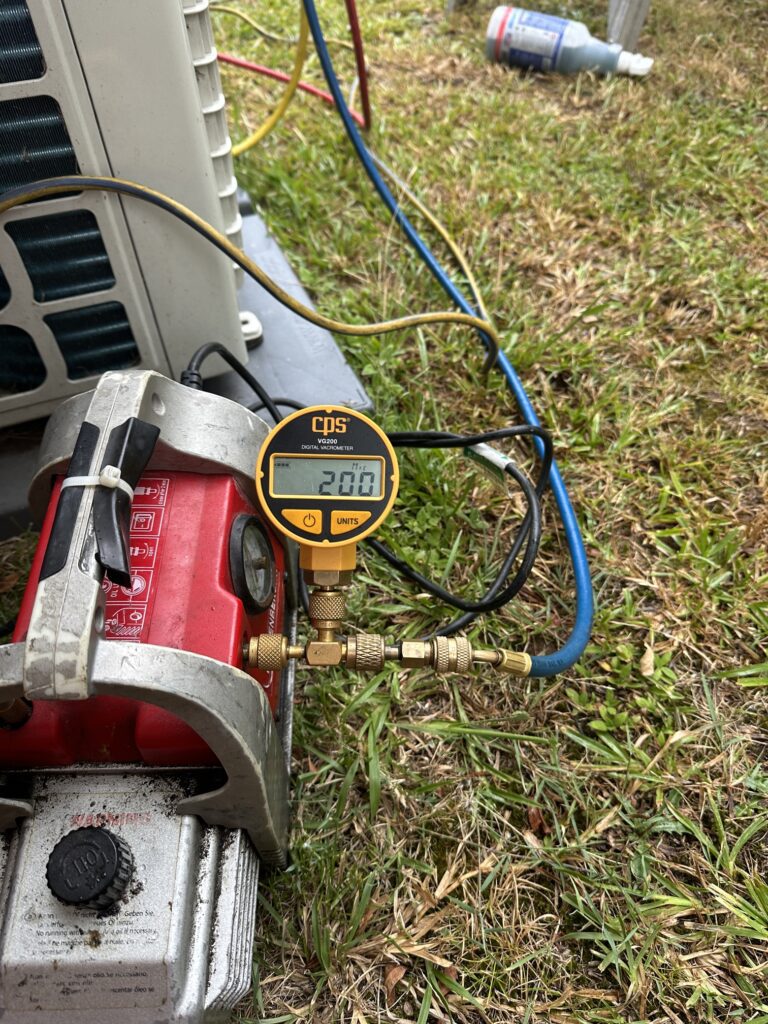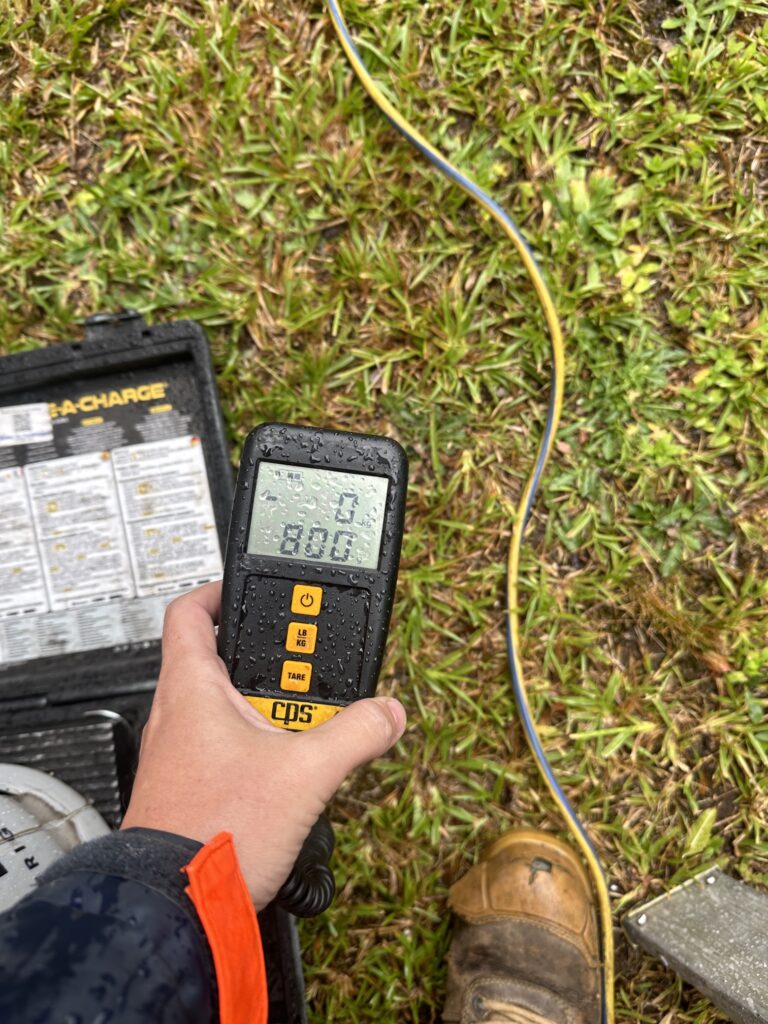Repair and Service a Split System Air Conditioner
Project Details
- Client – Residential
- Property Type – Brick home
- Location – Cessnock, NSW
- Task – Repair and service a split system air conditioner
Repair a Daikin Cora 7.1kW Split System Air Conditioner in Cessnock, NSW
Valley Air Conditioning recently attended a repair call for a Daikin Cora 7.1kW reverse cycle split system air conditioner in Cessnock, NSW. The resident had been experiencing issues with the system’s cooling performance, particularly during warmer weather, when the unit struggled to maintain comfortable indoor temperatures. Upon investigation, our technicians discovered that the problem was caused by a refrigerant gas leak, which significantly reduced the system’s ability to cool effectively. After pressure testing the unit, repairing the leak, and recharging it with new refrigerant, the team ensured the system was back to optimal performance. This article outlines the steps taken during the repair process and highlights the importance of proper air conditioning maintenance.
Initial Air Conditioner Symptoms and Call for Service
The resident in Cessnock first noticed the air conditioner’s declining performance during a particularly hot day. Despite setting the temperature low, the unit struggled to cool the room adequately, leading the homeowner to suspect a malfunction. When the Daikin Cora 7.1kW unit failed to perform even basic cooling functions, the resident contacted Valley Air Conditioning to investigate the issue.
Daikin’s Cora series is known for its energy efficiency and reliable performance in both heating and cooling modes, making it a popular choice for many homeowners. However, like all air conditioners, it relies on a sealed system of refrigerant gas to absorb and release heat. Any compromise in this system, such as a leak, can lead to significant drops in performance.
Diagnosing the Air Conditioner Problem: Pressure Testing
Upon arrival, the Valley Air Conditioning team conducted a thorough inspection of the unit to diagnose the problem. After performing basic checks on the system’s electrical components and thermostat settings, the team suspected a refrigerant leak as the root cause of the malfunction. This can happen when small punctures or worn seals allow refrigerant to escape over time, leading to reduced cooling efficiency.
To confirm the diagnosis, the technicians performed a pressure test on the system. Pressure testing involves injecting nitrogen gas into the air conditioner’s refrigerant circuit at a controlled pressure to detect any leaks. As the nitrogen fills the system, any areas where gas might be escaping become evident, allowing the team to pinpoint the exact location of the leak.
In this case, the leak was found in one of the refrigerant lines, which had developed a small puncture over time. This was likely due to wear and tear, a common issue in aging systems or units exposed to harsh environmental conditions.
Repairing the Air Conditioner Gas Leak
Once the leak was located, Valley Air Conditioning’s technicians set to work repairing it. The team carefully sealed the damaged section of the refrigerant line using professional-grade materials and methods, ensuring the repair would be both durable and long-lasting. In some cases, such as with older or severely damaged units, replacing the entire refrigerant line may be necessary, but in this case, a repair was sufficient.
Repairing refrigerant leaks is a delicate process that requires specialised knowledge and tools. Improper handling of refrigerant can be harmful to both the environment and the system, which is why it’s essential that only licensed professionals carry out such repairs.
Recharging the Air Conditioner Refrigerant
After repairing the leak, the next step was to recharge the system with refrigerant. The refrigerant is the lifeblood of an air conditioning system, allowing it to absorb heat from inside the home and release it outside. Without the correct amount of refrigerant, the system cannot operate efficiently, leading to poor performance and increased energy consumption.
Valley Air Conditioning’s technicians carefully weighed in the new refrigerant to ensure the system had the correct amount. Over- or under-charging the system with refrigerant can lead to further performance issues, so accuracy is critical. The technicians used specialised equipment to measure the exact quantity of refrigerant required based on the Daikin Cora 7.1kW system’s specifications.
Once the new refrigerant was added, the system was sealed and ready for testing.
Testing the Air Conditioner System for Proper Operation
With the refrigerant recharged and the leak repaired, the Valley Air Conditioning team conducted a final series of tests to ensure the Daikin Cora split system was operating correctly. They monitored the system’s cooling performance, checking the temperature output and airflow from the indoor unit to ensure it was now cooling effectively.
The team also tested the outdoor unit to ensure the compressor and condenser were working in harmony with the new refrigerant charge. A system that has been properly recharged should show noticeable improvements in performance almost immediately, and in this case, the Daikin Cora 7.1kW system was back to running at optimal efficiency.
In addition to performance testing, the technicians checked for any unusual noises or vibrations that could indicate potential future problems. Finally, they rechecked the system’s refrigerant pressure to confirm that there were no further leaks and that the repair was successful.
The Importance of Regular Air Conditioner Maintenance
While the repair was successful, the Valley Air Conditioning team took the opportunity to educate the homeowner on the importance of regular maintenance. Refrigerant leaks, while not uncommon, can be prevented or caught early with routine servicing. Over time, small issues such as worn seals, corroded pipes, or loose connections can lead to more significant problems like refrigerant leaks.
Regular maintenance services, such as checking refrigerant levels, cleaning filters, and inspecting the system for signs of wear, can extend the lifespan of an air conditioning unit and prevent costly repairs. The homeowner was advised to schedule annual maintenance checks to keep the Daikin Cora unit running efficiently for years to come.
Conclusion
Thanks to the expert team at Valley Air Conditioning, the resident in Cessnock can now enjoy the full benefits of their Daikin Cora 7.1kW reverse cycle split system air conditioner. By pressure testing the system, repairing the gas leak, and recharging it with the correct amount of refrigerant, the technicians restored the unit’s cooling performance. This repair not only resolved the immediate issue but also helped prevent future problems, ensuring the system would continue to provide comfortable indoor temperatures throughout the year.




